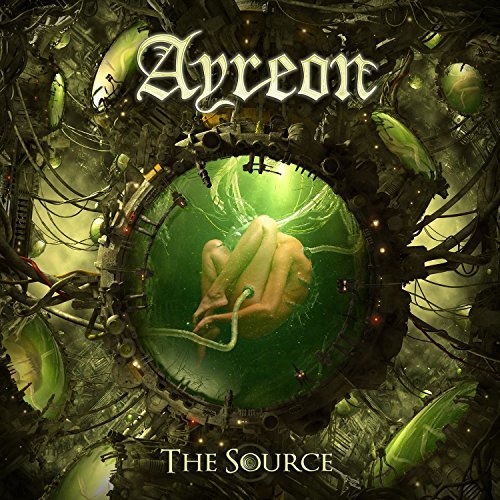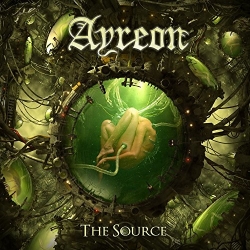With 2008’s 01011001, progressive metal visionary Arjen Anthony Lucassen seemed to have concluded the ‘‘Forever/Planet Y’ saga that stood as the foundation of his Ayreon project. In fact, its follow-up, 2013’s The Theory of Everything, was his first record under the moniker that held no ties to that universe (even the second Ayreon effort, 1996's Actual Fantasy, while not an overarching narrative, contained individual canonical tales). It’s fairly surprising, then, that The Source not only marks a return to that world, but acts as a direct prequel to 01011001.
For the most part, the album features everything that makes Lucassen’s work (especially his Ayreon projects) utterly brilliant: a wide array of masterful singers, astonishingly imaginative and technical musicianship, and some of the best songwriting in the field. However, it lacks some of the variety and immersion that made most of its forerunners so special. Specifically, it doesn’t explore as many diverse styles and techniques as longtime fans may expect, and whereas its three direct predecessors—particularly 01011001—provided richly atmospheric worlds in which to live, The Source comes across a bit more like a mere collection of tracks. That said, it’s still an outstanding work in Lucassen’s catalog that, like just about everything else he touches, serves as a benchmark for the genre.
One of the most noticeable traits of The Source is its abundance of in-your-face aggression; in fact, it most closely resembles the heaviest Ayreon opus to date, 2000’s Flight of the Migrator, upon early listens. This isn’t a coincidence, though, as Lucassen initially conceived it as a new entry for his harsher Star One offshoot. Naturally, he used the vocal skills of both returning progressive metal elites (like James LaBrie, Tommy Karevik, Simone Simons, and Floor Jansen) and newcomers (such as Tommy Giles Rodgers, Russell Allen, and Nils K. Rue) to bring his account to life. (Interestingly, Lucassen doesn’t offer sing this time around.) Likewise, frequent drummer Ed Warby is back, as is keyboardist Joost van den Broek, while guitarists Paul Gilbert and Guthrie Govan—as well as keyboardist Mark Kelly—make their Lucassen debut here. Together, they uphold the staggering level of prowess and personality that Ayreon ensembles are known for, ensuring that The Source is immeasurably lavish, emotional, and catchy.
Just as The Theory of Everything was broken into four 20+ minute “Phases,” the plot of The Source is divided into four 20+ minute “Chronicles.” Lucassen describes the story as follows:
[It] is set six billion years in the past relative to Earth. It begins on Planet Alpha, a world in the Andromeda system where computer intelligence has far surpassed that of humanity. Alpha is facing a massive global crisis, with ecological and political catastrophes threatening all human life. The Alphans (our human ancestors) try to save their planet by entrusting the global computer mainframe—The ‘Frame—to find a solution. Given total control of the planet, the ‘Frame reaches the logical conclusion that its creators are the cause of all the trouble. The only way to solve Alpha’s problems is to exterminate humanity. This leaves the Alphans no other option than to try and escape their horrific fate. But their escape comes at a terrible price.
The first movement, “The ‘Frame,” kicks off with “The Day That the World Breaks Down,” a multisectional tour de force of hooks, riffs, and persistent alternating dispositions that successfully introduces the major characters and central conflicts. It’s not quite as impeccably gripping and unified as “Age of Shadows” from 01011001, but it comes close and accomplishes a similar purpose. Among its greatest moments are Michael Mills’ self-penned series of “01011001” vocal meshes halfway through—a clever callback to a similar moment in “Age of Shadows”—and the ensuing bluesy portion that recalls Into the Electric Castle. Overall, it’s a stunning opener that gives each contributor a moment to shine and sets the stage for what’s to come.
The following two pieces—“Sea of Machines” and “Everybody Dies”—are equally enjoyable. The former is a cautionary and mournful gem with some of the most engaging melodies and beautiful string arrangements Lucassen has ever devised; in particular, he makes great use of Rogers’ trademark clean delivery. In contrast, the latter offering is a delightfully histrionic slice of malevolence whose interwoven operatic outcries are complemented perfectly by eccentric instrumentation and blistering rhythms. It’s a nonstop assault that might be too relentless and basic—as some later entries are—if it weren’t so colorful and enthralling. All in all, “The ‘Frame” may encompass fewer tracks than the subsequent units, but it’s easily the strongest of them.
Next comes “The Aligning of the Ten,” which starts with a fairly straightforward and dense rocker, “Star of Sirrah.” Its opening and closing guitar arpeggios are wonderfully poetic and break up the surrounding fury nicely. In general, it also conjures Into the Electric Castle because of its call to action premise of joining several figures for a shared goal. Like “Mirror of Dreams” from The Theory of Everything, “All that Was” is primarily a grief-stricken duet (led by Simons and Jansen) with plenty of minstrel splendor. It houses some of the most striking dynamic changes and emotional punches on the whole LP, demonstrating how adept Lucassen is at writing gentler material.
Unfortunately, “Run! Apocalypse! Run!” is a surprisingly generic bit of progressive metal urgency; sure, it moves the plot along fine and contains more awesome outbursts from Mills, but its dominant chaos is too common to stand out. Thankfully, closer “Condemned to Live” restores The Source to greatness with more complex allure. Once again, various characters trade off passages—sometimes repeating the same ones, which is an Ayreon staple—while the measures fluctuate around agitated symphonic gold. Its sense of narrative desperation and catchy comradery is matched by enthralling musicianship, showcasing Lucassen’s compositional mastery (especially when it comes to ending the first halves of his epics with effective cliffhangers).
Chronicle III, “The Transmigration,” encompasses the initial quartet of the second disc. A piercing chant explodes during the opening moments of “Aquatic Race” and is followed by more hectic riffs, gruff percussion, and back-and-forth dialogues between performers. Like many of Lucassen’s best multipart sequences, it’s the balance of rage and repose that truly shines here, with the aforementioned chant—“Get ready for takeoff / and forget the ‘Frame”— providing an intense and entrancing juxtaposition to a soft and endearing passage (first from Michael Erikson and then from Simons), as well as a silky contribution from Rogers. The music blends confrontation and calmness with equal poise, guaranteeing that you’ll do plenty of headbanging in-between pondering introspective tenderness.
Afterward, “The Dream Dissolves” is a sparse and sorrowful reflection highlighted by touching croons from Jansen and Simons, robust orchestration, and some charmingly quirky sci-fi score that evokes the spacey majesty of The Dream Sequencer. It’s easily among the most passionate and involving inclusions in the set, and it serves as a fine prelude to “Deathcry of a Race,” whose aggressive sophistication is made more distinctive with its flurry of flutes, operatic singing, and overarching Indian influence. It segues directly into “Into the Ocean,” a piece that really feels plucked from a Star One record (or The Flight of the Migrator) due to its synthesis of biting guitar and keyboard riffs (in conjunction with over-the-top declarations). It’s engaging enough, but it also feels too run-of-the-mill, like it's checking off all of the boxes for a Lucassen track without doing anything special.
The fourth and final movement, “The Rebirth,” fares better overall, with “Bay of Dreams” finding LaBrie and Rogers lulling listeners into the concluding quintet with some great melodies. Backed by woodwinds, unearthly noises, and a hypnotic acoustic guitar arpeggio (that harkens back to “Star of Sirrah”), they complement each other superbly by channeling a true vocal merger of Dream Theater and Between the Buried and Me. Likewise, Mills’ intricate interruption—“Will you still be needing me? / Will you still be feeding me?"—is an interesting nod to a Beatles classic. Expectedly, the song builds as more singers and timbres are added, culminating in a dense distress that really conveys the sense of impending finality.
To be honest, aside from its industrial/bluesy instrumentation section near the end and the inherent coolness of an arguable throwback to “Age of Shadows” (“Forever we’re free / And forever we’ll be / And forever we will dream“), “Planet Y is Alive” possesses the same kind of uninspired genre formula as “Run! Apocalypse! Run!” It’s not outright bad, but it is bland and even a bit irritating. “The Source Will Flow,” on the other hand, once again uses the LaBrie/Rogers duality to great effect (including a wink to “Beneath the Waves” from 01011001 that’s so subtle that it may not even be intentional). Joining them are gorgeous harmonies from Simons and more dreamy passages with strings, flutes, acoustic guitar strums, and peaceful percussion.
The final trio of tracks closes The Source wonderfully. "Journey to Forever” recalls the choral grandeur of “Aquatic Race” in a warmer and more jovial way. Matched with welcoming Celtic arrangements, it aptly conjures a sense of communal optimism with which you’ll want to sing-along. Affectively, “The Human Compulsion” acts like a disturbing twist ending, with its cold uncertainty expressed strongly by having computerized dissonance and a riff from “Sea of Machines” blanket the brief hesitations of each major character. It then bursts into “March of the Machines,” which, as you may guess, is an ominous proclamation about robotic dominance that subtly—and brilliantly—sets the stage for what’s to come in the storyline. Without spoiling it specifically, suffice to say that longtime fans hoping for a Rogue One moment (you know what I mean) will definitely smile during the final seconds of the record.
Beyond being a masterful concept album piece-by-piece, The Source soars when it comes to conceptual continuity and fan service. In addition to the aforementioned connections, there are many more Easter eggs to find, such as repeated references to “liquid eternity” and “cold machines,” plus a one-off link to The Human Equation (see if you can find it!). Of course, familiarity with the Ayreon universe isn’t required to enjoy the LP, but it certainly helps. Either way, the fact that Lucassen put such attention to detail into making the full-length fit within his realm only further demonstrates his ingeniousness and love for his craft.
Despite its slightly overbearing lack of variety and immersion, The Source is an incredible work from start to finish. If it weren’t for the astronomical bar set by The Human Equation, 01011001, and The Theory of Everything, it would be Lucassen’s finest achievement. That it falls just short of those is a tad disappointing but easily understandable and forgivable, as it still ranks miles above the output of just about every other progressive rock/metal artist. On that note, almost no one else in the genre—if not the entire modern music landscape—makes music this ambitious, focused, sundry, and conceptually resonate; the fact that Lucassen was able to do it once is admirable enough, so his continued excellence over the past twenty years is downright astonishing. The Source may not best some of its predecessors, but it still topples nearly all its contemporaries.


